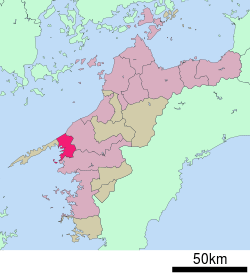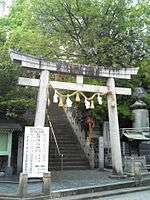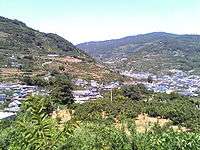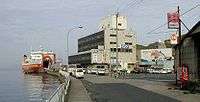Yawatahama, Ehime
| Yawatahama 八幡浜市 | ||
|---|---|---|
| City | ||
| ||
 Location of Yawatahama in Ehime Prefecture | ||
 Yawatahama Location in Japan | ||
| Coordinates: 33°28′N 132°25′E / 33.467°N 132.417°ECoordinates: 33°28′N 132°25′E / 33.467°N 132.417°E | ||
| Country | Japan | |
| Region | Shikoku | |
| Prefecture | Ehime Prefecture | |
| Government | ||
| • Mayor | Ichiro Oshiro (since April 2009) | |
| Area | ||
| • Total | 133.03 km2 (51.36 sq mi) | |
| Population (March 31, 2012) | ||
| • Total | 38,307 | |
| • Density | 287.96/km2 (745.8/sq mi) | |
| Symbols | ||
| • Tree | Mikan (温州蜜柑 Unshū mikan) | |
| • Flower | Narcissus (水仙 Suisen) | |
| Time zone | Japan Standard Time (UTC+9) | |
| City hall address |
1-1-1 Kitahama, Yawatahama-shi, Ehime-ken 796-8501 | |
| Website |
www | |
Yawatahama (八幡浜市 Yawatahama-shi) is a city located in the southwestern part of Ehime Prefecture, Japan, and has the largest fish market on Shikoku. The Mikan is the featured agricultural product.
As of March 31, 2012, the city has an estimated population of 38,307, with 16,885 households and a population density of 287.96 persons per km². The total area is 133.03 km².
On March 28, 2005, Yawatahama absorbed the town of Honai (from Nishiuwa District) to create the new and expanded city of Yawatahama. Regular bus service connects Honai and Yawatahama.
History

It is said that name "Yawatahama" (八幡浜) comes from long ago when debris from a festival at the main Hachiman (八幡) shrine in Usa, Ōita, floated up on the beach (浜) in what is now Yawatahama.[1] In 1889, during the Meiji Period the Yawatahama became a city under the new municipal system.[1]
Around that time, Yawatahama was referred to as the Manchester of Shikoku due to rapidly increasing industry. As an industrial center for Ehime, the first bank in Ehime was opened in Yawatahama in 1878.[1] In addition, in 1889, Yawatahama was the first city in Shikoku to burn an electric light.
Town Mergers
- February 11, 1935 - Yawatahama combined with Senjo, Hitada, and Kamiyama
- February 1, 1955 - A locality of Futaiwa, as well as Hizuchi, Maana, and Kawakami were added.[2]
- March 31, 1955 - Nishiuwa District's Isotsu, Miyauchi, Kawanoishi, and Kisuki towns merge under the name Honai.[2]
- March 28, 2005 - Yawatahama and Honai were merge under the name Yawatahama[3]
Geography

Yawatahama exists as a link between The Sadamisaki Peninsula, Japan's longest Peninsula, and the rest of Shikoku. For a long time, the city's naturally good harbor has served as an important one for Ehime Prefecture and Shikoku. Flat land is exceedingly sparse and the hilly terrain has been used for citrus production.
To the east of Yawatahama is Ōzu which is connected by Japan National Road 197's Yoruhiru Tunnel (夜昼トンネル).
Nearby Cities and Towns
Transportation

Train
An express JR Shikoku Station is located in the town giving Yawatahama frequent train service throughout the day.
Ferry
Yawatahama has a small port which provides regular ferry services to the cities of Usuki, Ōita and Beppu, Ōita on Kyūshū.
Bus
Private and public bus companies including Iyotetsu and Uwajima Unyu companies provide intra and inter-city transport. Some companies offer long distance bus trips as far as Kobe, Osaka, and Tokyo.
Economy
Yawatahama has been known for fishing and mikan production.
Agriculture

Known as Japan's best producer of mikans, Yawatahama's agricultural industry centers around the cultivation and production of these citrus fruits. Mikan groves are primarily located on the city's mountain sides in order to receive the maximum amount of sunlight.
Yawatahama's mikan production is governed by the Nishiuwa Agricultural cooperative, which is responsible for the distribution and branding of Yawatahama mikans. This cooperative distributes the fruits nationwide under such brand names as "Hinomaru" (日の丸) and "Kawakami" (川上).
Occasional snow during the winter months can deal great damage to the mikan industry.
Marine Products

Yawatahama Port is located on the coast of Ehime, bordering the Uwa Sea, at the Sadamisaki Peninsula. Because of its location as well as its proximity to the Inland Sea, Yawatahama's fishing and marine products industry had been able to prosper for many years.
As a major fishing port for Ehime Prefecture, the town has a daily fish market where marine products are available at wholesale to restaurants and supermarkets. A few times each month, the town offers a weekend fish market which is open to the public. While the Uwa Sea offers a wide variety of fish and shellfish products, Yawatahama's regional specialty is Japanese Jack Mackerel (鯵 "aji").
Yawatahama's marine product industry extends beyond just fresh fish. The town also specializes in fish products including fish paste and fishcakes made from pureed white fish. This is known as kamaboko (蒲鉾). Yawatahama, along with Uwajima, have numerous shops selling a variety of kamaboko.[4] One local delicacy is jakoten (じゃこ天), or kamaboko fried tempura-style.
Education
High schools
- Yawatahama High School
- Yawatahama Technical High School
- Kawanoishi High School
Junior High Schools
- Atago Junior High School
- Yashiro Junior High School
- Matsukaya Junior High School
- Maana Junior High School
- Futaiwa Junior High School
- Ōshima Junior High School
- Honai Junior High School
- Seiseki Junior High School
Famous residents
- Moriyuki Kato, the governor of Ehime Prefecture
- Chūhachi Ninomiya, a Japanese aviation pioneer
- Maedayama Eigorō, a sumo wrestler who was the sport's 39th Yokozuna
- Jōkō Ninomiya, founder and director of Enshin Karate
References
- 1 2 3 (Japanese) Yawatahama City History before 1950
- 1 2 (Japanese) 1950s Yawatahama City History
- ↑ (Japanese)2000s Yawatahama City History
- ↑ http://www.pref.ehime.jp/faz/industry/pdf/e/13.pdf
External links
| Wikimedia Commons has media related to Yawatahama, Ehime. |
- Yawatahama City official website (Japanese)
- Yawatahama Sea Road (Japanese)
- Yawatahama Mountain Biking (Japanese) and (English)